Garlic, lovingly called “the stinking rose,” brings flavor to dishes from many of the world’s cuisines. Garlic’s proven health benefits were suspected long before chemical analysis and clinical trials were invented.
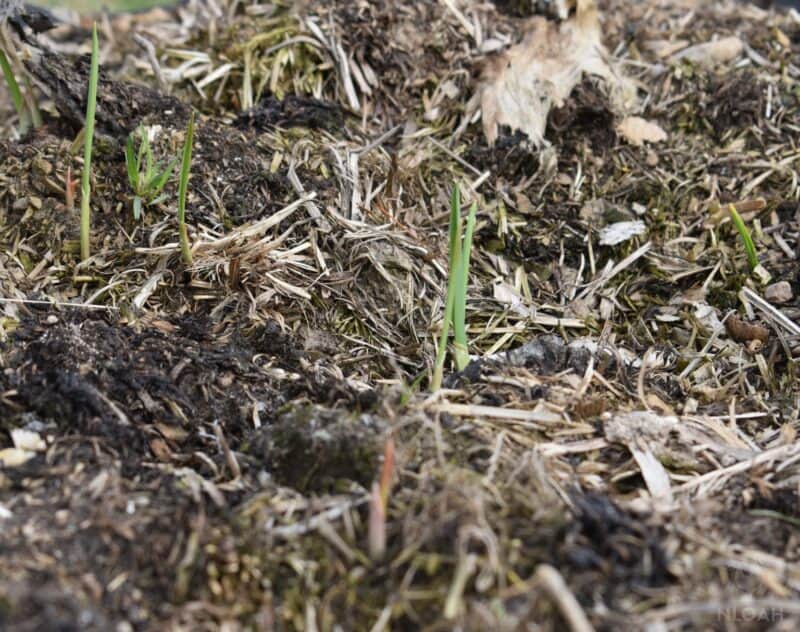
This awesome bulb has had a mythos for centuries. It is no coincidence it was even thought to have supernatural powers such as keeping vampires away. Ancient armies also used garlic for bravery and stamina.
Why Grow Garlic?
Garlic is fun and easy to grow. There really is not any tedious element to this crop.
Growing your own garlic gives you access to a whole world of flavor and texture beyond the typical grocery store variety.
Growing garlic also gives you access to garlic scapes if you grow the hardneck variety. This is a fun and ephemeral harvest that is often not available commercially.
Garlic is typically not preyed on by insect pests, and its odor can repel insects from other parts of your garden.
Not all folk remedies have stood the test of time, but grandparents who insisted on consuming garlic for health were right on the money.
Garlic contains many compounds, but allicin (pronounced like my name, Allison) is the main active ingredient. Allicin has been proven in clinical trials to have antibacterial, antiviral, and tumor fighting properties.
Selecting Garlic Varieties to Grow
Grocery store garlic: To Plant or Not to Plant?
You can plant garlic from the grocery store. There are some good reasons not to.
- Store bought garlic may carry viruses that can proliferate in your soil.
- Most commercial garlic comes from Gilroy, California. If your climate is different from Gilroy’s, your garlic may not overwinter well.
- Some grocery store garlic is treated to prevent sprouting. This will cause lower sprouting rates and slower growth when planted.
- You miss out on the incredible variety of flavor and texture available in garlic for small scale growers.
- If you sell your crop, your customers will appreciate a break from everyday garlic.
That being said, if you want to plant garlic from the grocery store, do it. It’s your life, it’s your land, and you’ll probably get some garlic out of the deal. If someone wants to be a snob about your choices they can snob around on their own land! Here are some reasons to plant grocery store garlic:
- Store bought garlic has a lot of medicinal compounds
- Store bought garlic is much cheaper that stock from seed catalogs.
- Garlic viruses are not the end of the world for small scale growers. Just destroy the plants, practice crop rotation, and move on.
- Store bought garlic is bred for a high yield and good storage.
If you do go store bought, make sure to practice good crop rotation. Do not plant store bought garlic in soil that has had garlic or onions in it for the past three years. Introduced viruses can combine with native viruses to make garlic sicker.
Hardneck vs. Softneck Garlic
If you are going with an artisan variety, your first decision is hardneck vs. softneck.
The “hard neck” in hardneck garlic is a hard, twig like stem that runs through the garlic head. The cloves circle around the stem.
The “soft neck” in soft neck garlic is papery skin that comes together at the top of the head. Soft neck garlic is what you typically see at the store. As you know from your own kitchen, the soft neck cloves form concentric circles.
| Hardneck Garlic | Softneck Garlic |
| Shorter storage | Longer storage |
| Commands higher price per head | Commands lower price per head |
| Large, uniform cloves | Both large and small cloves |
| More medicinal properties | Still a lot of medicinal properties, but less than hardneck |
| Slower growth | Faster growth |
| Better performance in cold climates | Better performance in mild climates |
| Form scapes | Do not form scapes |
| Cloves easier to peel | Cloves harder to peel |
| Hundreds of varieties exist | Probably less than 50 varieties exist |
| Forms bulbils (discussed later in the article) | Does not form bulbils |
Some people say that hardneck garlic has better flavor than softneck. Personally, I find it hard to make that generalization because there are many varieties of both kinds of garlic.
There is another category called “great headed” or “elephant garlic.” These plants are actually pretty different from the other garlics in terms of their flavor, growing requirements, and genetics.
Once you have chosen whether to plant hardneck or softneck garlic, the decision comes down to climate and flavor. Your garlic is meant to overwinter. You want to pay attention to its cold tolerance and its moisture tolerance. Do you live somewhere where it rains all winter? Or does the ground freeze solid? Both of these are challenging conditions in their own way.
Many garlics are named for places, which can give you an idea of the climate they were bred for. When I lived in rainy Southeast Alaska, I went for “Oregon Blue.” Now that I live in the interior, I’m more likely to plant “Uzbekistan,” or “Siberian Purple.”
Your local cooperative extension can be helpful in selecting a variety for your climate. You can also ask your neighbors which varieties performed best for them. Seed catalog customer service representatives are typically helpful and knowledgeable as well. If you tell them about your winters, they can help you find varieties that are likely to succeed.
Once you have narrowed the field to varieties for your climate, it comes down to flavor! Do you want mild garlic or the hottest garlic possible? It’s up to you!
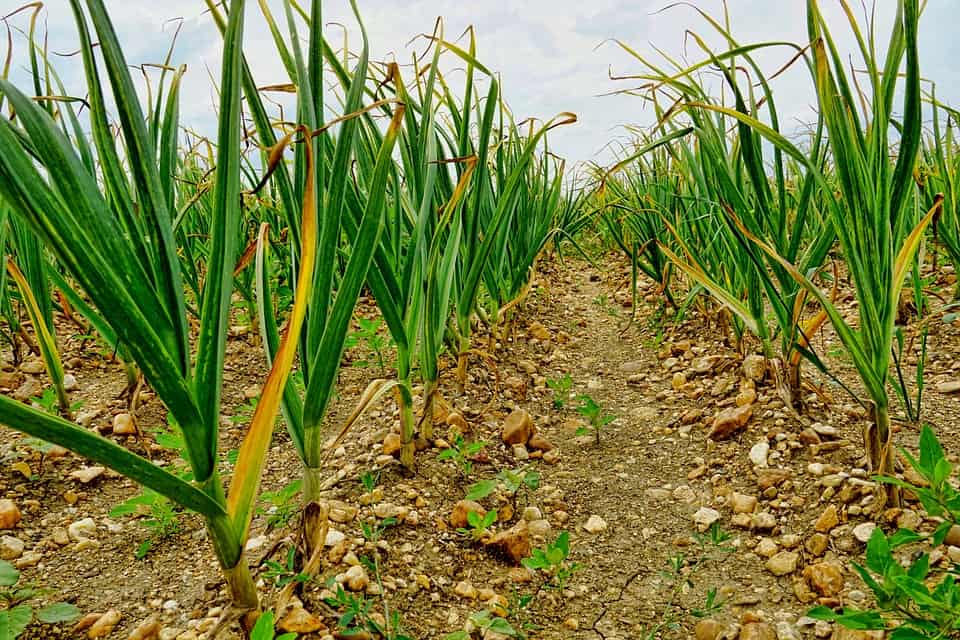
When to Plant Garlic
Fall Planting Garlic
Garlic develops its rich flavor from slow growth that begins in the fall and continues the following spring.
Garlic should be planted fairly late in the fall, 6-8 weeks before the ground freezes.
You want the clove to have a chance to start creating a root system, but you don’t want the plant to put too much energy into greens. You also don’t want to plant too late, because it is important for the plant to have some time to develop roots.
The best way to get the timing right for your specific area is to consult with neighbors or your local Cooperative Extension. You could even ask a grower at a local farmers’ market. Most growers are happy to share a few tips with their customers.
For most temperate growers, garlic should be planted in late October. For growers in very cold climates like me, September is the time to plant.
To plant garlic, first you break apart the heads into individual cloves:
Next, plant the cloves into the ground, root side down. This is the root side:
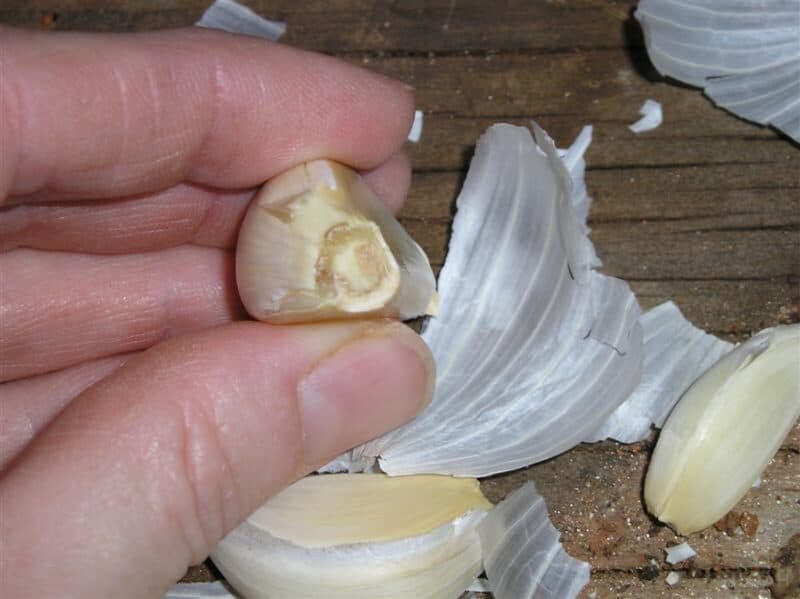
Simply push the cloves into loose soil until the tips are just barely below the surface of the dirt. Space them about 8 inches apart. Then cover them up with a thin layer of soil.
Garlic requires well draining soil, or else it’ll rot in the ground. It is benefited by the addition of finished compost or aged manure. Mulch lightly over the winter with hay or straw.
In the spring, (hopefully!), a green curly flower stem will shoot up from the garlic heads:

Spring Planting for Garlic Greens
Some growers also plant a small crop of garlic in the spring for garlic greens. These can be harvested and utilized like green onions, but they have a garlic flavor. One small row of cloves will produce garlic greens for a household throughout the growing season.
You can plant cloves for garlic greens as soon as the soil can be worked. These plants will survive a frost.
Dig up the cloves at the end of the season. This is good hygiene to prevent diseases from proliferating in the soil. You may also find that some of the cloves are still edible, or can be saved for fall planting.
Where to Plant Garlic
Companion Planting
In areas with a lot of insect pests, garlic’s odor can protect other plants. Lettuces and other bug-prone plants could benefit from this.
According to permaculture practitioners, garlic is a good companion for roses, apples, and peaches. It is a poor companion for peas, beans, brassicas (cabbage, kale, mustard, broccoli, etc), and strawberries.
Garlic should not be planted in soil that held brassicas the previous growing season. This can reduce the garlic yield.
I have created garlic patches on the outskirts of my gardening world because garlic doesn’t need much tending. However, by doing so I have made it easy for weeds to encroach upon my garlic bed. I would recommend giving garlic some kind of buffer from encroaching plants to prevent them from taking over.
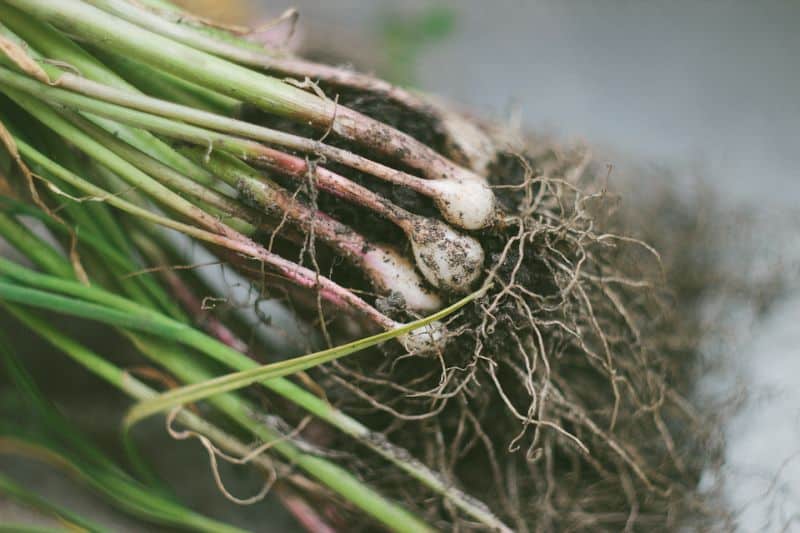
Step by Step Guide to Growing Garlic
Preparing Your Soil
Drainage is very important to garlic, as overly wet soil can cause rot. You also want to make sure your soil is fluffy to give the garlic head room to grow. Mix a healthy dose of green manure or compost into your soil a week or two before planting.
Garlic Seeds?
Garlic has been cultivated to grow from cloves for so long it is extremely difficult to get a seed from a garlic plant. Until some scientists made a concerted effort to induce garlic to flower, people were not sure whether garlic was still capable of producing seeds. Apparently, it can do it, but this is not a normal farm occurrence.
Some garlic will produce a head that looks like a flower. However, it does not have sex organs like a true flower. It is a collection of tiny bulbs growing on an aerial stalk! Some people do plant these, and I will discuss this in a later section.
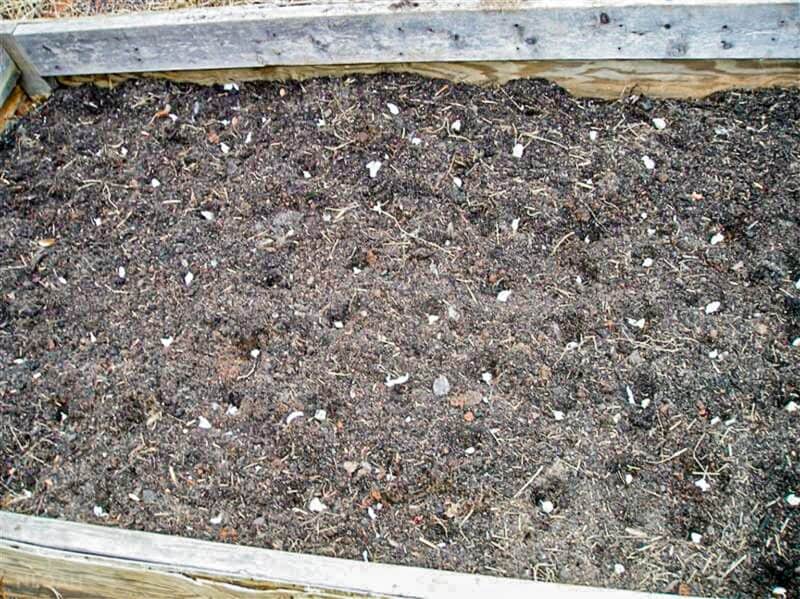
Planting Cloves
The majority of growers plant cloves to grow garlic. Each clove will (hopefully) grow into a large, complete head.
It is tempting to eat the large cloves and plant the small cloves. However, you will get bigger heads if you keep the largest cloves for planting.
Keep the heads whole until you are ready to plant your garlic. When you break the head apart, pay special attention to the small woody area at the base each clove. This is where the roots will develop; make sure all the cloves you plant have a piece of this. Remove as little of the peel as possible.
Plant cloves 2-3 inches (5-7 cm) deep, with the pointy side up. Space cloves at least 6 inches (15 cm) apart. Make rows 1 1/2- 2 feet (about 0.5 m) apart. Water well. Cover with at least 4 inches of mulch.
Planting Bulbils
This is something I have never done personally, but I can see its advantages.
Garlic bulbils are little tiny bulbs that grow in a flower-like umbel that forms at the top of hardneck garlic scapes.
Typically, you want to remove scapes from the garlic plant before bulbils form to prevent them from drawing energy away from your underground bulb. However, some people allow the umbel to form and then plant the bulbils.
There are two huge advantages to planting bulbils. One is that bulbils do not pick up diseases due to their lack of contact with soil. The other is that there are more bulbils than cloves on a garlic plant.
Eventually, one group of bulbils will produce many more plants than one underground head. This makes planting bulbils much more economical than planting cloves.
So, why doesn’t everyone use bulbils? The main reason is time. Cloves will form whole heads the spring after they are planted.
Bulbils form small rounds the first year, small heads the second year, and they finally form “normal” sized heads the third year. In the interim, if you have any problems storing your bulbils between plantings your whole crop is lost.
Mulching Garlic
Most growers place several inches of mulch on top of their garlic for the winter. This mulch prevents slumbering garlic from sprouting early during a midwinter thaw. If this occurs, the ensuing return of winter temperatures will damage and possibly kill the plant.
Some growers in truly wet climates that are not very cold, such as Northern California, may choose not to mulch. There is a risk in these rainy climates of mulch helping to create conditions for rot.
In the spring, most of the mulch is removed. Of course, gardeners and farmers are not a uniform bunch. Some garlic farmers report that mulch invites grazing animals or encourages mold. They do not keep any mulch on their garlic at all during the growing season.
Others do use mulch to regulate moisture and discourage weeds. Your specific growing conditions will help determine what is right for you.
Watering Garlic
If garlic gets too much water before the ground freezes, it will not prepare itself properly for winter. I typically water my garlic in well when I plant it, and then I do not water it again.
Garlic should be kept moist during the spring and early summer while it is growing. However, it is important not to over water the plants as this can lead to mold and other problems.
Once the plants are fairly mature, it is time to stop watering. Watering too late in the season can cause garlic to rot, split its skin, or have other problems that will make it keep poorly.
If you grow hardneck garlic, you can stop watering when any remaining scapes have turned woody. If you grow softneck, stop watering in midsummer, when the green plants appear to have reached a plateau in their growth.
When you stop watering, remove any mulch you have left on the bed. This will further aid the garlic bulbs in drying out.
Weeding
Garlic does not compete well with other plants. It is important to keep your garlic bed weeded.
I have a theory about this but I do not know if there is real evidence to support this. According to the literature I have read, humans have cultivated and prized garlic for thousands of years. Of course, they would have weeded. I wonder if those thousands of years of weeding helped the plant evolve to become “lazy” about competing on its own.
Fertilizing Garlic
The best fertilizer for garlic is compost. It should be worked into the soil a couple of weeks before planting. Plants should be top dressed with compost when spring leaves begin to poke up through the ground.
If you do not have enough compost, use a nitrogen rich fertilizer for garlic. Fertilizers are labeled according to their Nitrogen, Phosphorous, and Potassium content (N-P-K). The numbers will always be in the same order. For example, a typical bat guano, at 10-3-1 is 10% nitrogen, 3% phosphorous, and 1% potassium. Bat guano and blood meal are both rich in nitrogen.
Work fertilizers gently into the soil near the base of each plant. Use just a teaspoon or two: more can burn the plant.
Common Diseases and Disease Prevention
Diseases are not usually a big problem for garlic. However, there are a few that can occur. Keeping your plants well-nourished with compost can strengthen their immune system against diseases. I know I repeat myself about crop rotation, but I cannot emphasize enough how important this practice is to keep soil healthy.
Some fungal/rot type diseases occur in wet areas.
The best preventive measures against fungal or rot type diseases are:
• Utilizing crop rotation
• Removing all plants and plant parts from the area after harvest
• Planting in reasonably well-drained soil
• Choosing varieties bred for wet climates if you live in a wet climate
There are also some viruses that affect garlic. It seems that many garlic plants carry at least one virus, and that they are able to overcome its effects. However, if a plant is infected with a combination of several viruses it can affect both yield and storage properties.
The symptoms of garlic suffering from a heavy virus load include yellowing streaking or striping on foliage. Garlic bulbs from these plants may be smaller in size and they may not keep as well.
Severe garlic virus symptoms are not extremely common, but localized areas occasionally experience outbreaks.
If you suspect virus infection is affecting your garlic yield:
• Be extra special double sure to utilize multi-year crop rotation.
• Do not replant cloves from this garlic or give to others to plant.
• Start your next crop with certified, virus-free garlic from a seed provider.
• Make sure to remove all diseased plants and plant parts
Pests and Pest Deterrence
Pests are usually not a big problem for garlic.
I have had some cloves get dug up by voles during large vole years. Netting or fencing can help a little bit with this. It is also helpful to fertilize your soil a week or two before planting. By the time you plant the fertilizers’ odor will not be as strong. This may help to attract fewer pests to the area.
Some growers eschew mulching because small rodents may snuggle up into the mulch. This decision really depends on your particular climate and whether rodents are a problem.
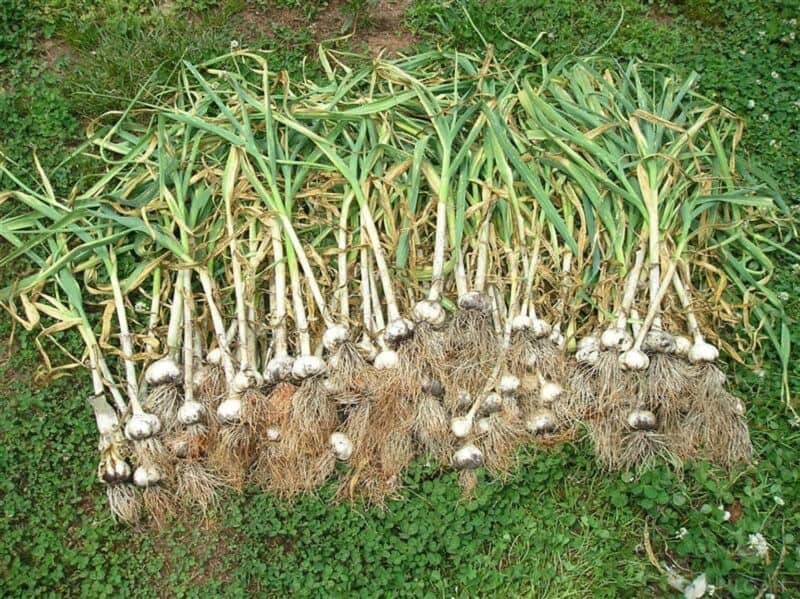
Harvesting Garlic Scapes
Garlic scapes are tall, curly stalks that grow up in the middle of hardneck garlic plants. They are ready to harvest when they are taller than the rest of the plant. There is a relatively short window within which garlic scapes are harvestable. They become woody quickly. Keep an eye out for scapes emerging from your plants, and cut them as soon as they are ready.
If you are interested in experimenting with bulbils, leave a couple of scapes to mature on the plant. The bulbils develop within an umbel on the scape.
Use a sharp knife to cut the scape as far down as you can without damaging any leaves. Even if you don’t eat all of your scapes, you do want to remove them from all of your plants. They take energy away from the bulb developing underground.
If you can’t eat all of the scapes you harvest at once, they do make incredible pickles. This is the best way to store garlic scapes.
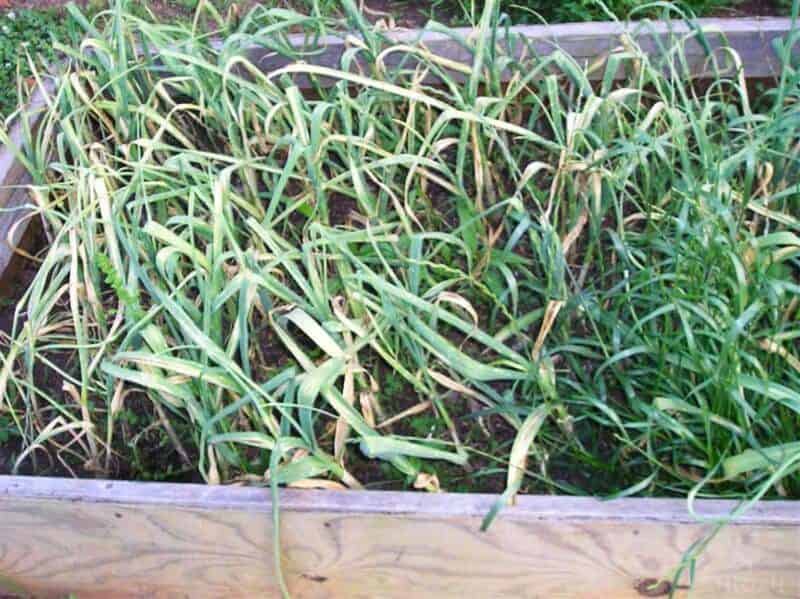
Harvesting Garlic
Harvest garlic when the bottom few leaves on the plant are brown, but the top is still green.
Harvest garlic on a day when the soil is dry. Gently loosen the soil around the plant with a small hand tool, then pull out the bulb with the stalk attach.
Knock big chunks of dirt off the plant, but don’t clean them thoroughly. Definitely do not rinse them; you want the garlic to be as dry as possible.
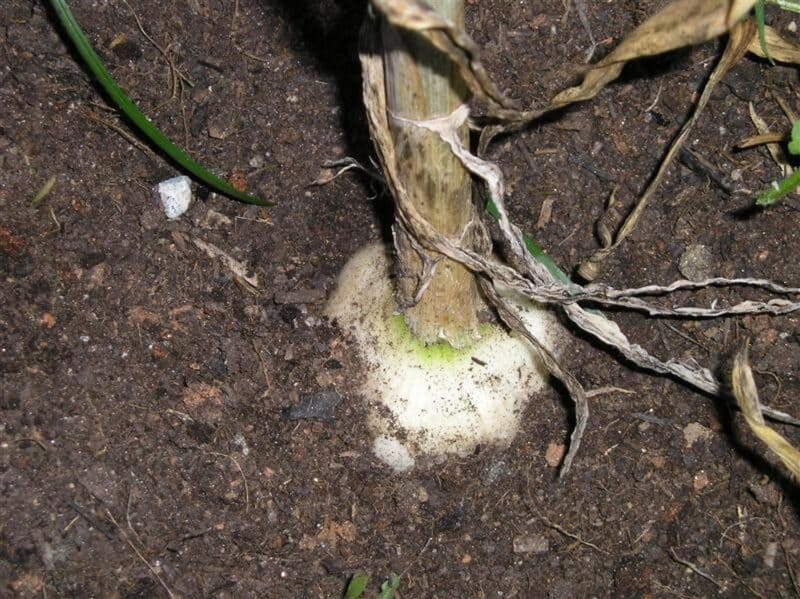
Storing Garlic
Garlic needs at least a couple of weeks to “cure,” or dry out, before long term storage. Ideally, hang garlic in bundles in a dark, dry, well-ventilated place. You can also spread your bulbs on screens or racks. The garlic is cured when there are several layers of dry, papery skin on the bulb.
Softneck garlic can be braided together and hung in braids. Hardneck garlic stalks should be cut off with a sharp tool about an inch (about 2 cm) above the bulb. Trim off the roots. Wipe dirt off gently, removing as little skin as possible. If any bulbs are not well sealed in their wrappers, eat these first.
Your absolute biggest cloves should be saved for planting next year. You can keep planting your own garlic cloves until you see any problems with the plants. If you start to experience a decline in your bulb size even with super duper excellent crop rotation, start over with stock from a trusted supplier.
Once your garlic is cured, the best place to store it is one that is cold but not freezing (33-38 degrees Farenheit or 1-3 degrees Celsius). Using baskets or other well ventilated containers will help prevent mold from forming. Hanging braids of garlic is another way to keep it aerated.
If you don’t have a dry place that is quite as cold as 33-38 degrees, don’t worry about it too much. Keeping the garlic in a dry and dark place is more important than the exact temperature. Just keep the garlic as cool and dry as you can, and keep an eye on it over time.
If any of your garlic bulbs start to sprout, make sure to eat those right away.
Cooking with Garlic Scapes
Garlic scapes are excellent in any recipe you would use for either green beans or asparagus. They have the same texture as these vegetables, but with a garlicky kick.
I love to:
- Brush them with oil and barbecue them
- Chop them up and add them to vinaigrettes
- Brush them with oil and use them as pizza toppings
- Saute them and serve them on top of a filet of fish
I have enjoyed garlic scape pickles made by small scale garlic farmers, but I have never made them myself.
Garlic is a treat to grow, and an even better treat to eat. I hope you have a wonderful time with garlic in your neck of the woods!
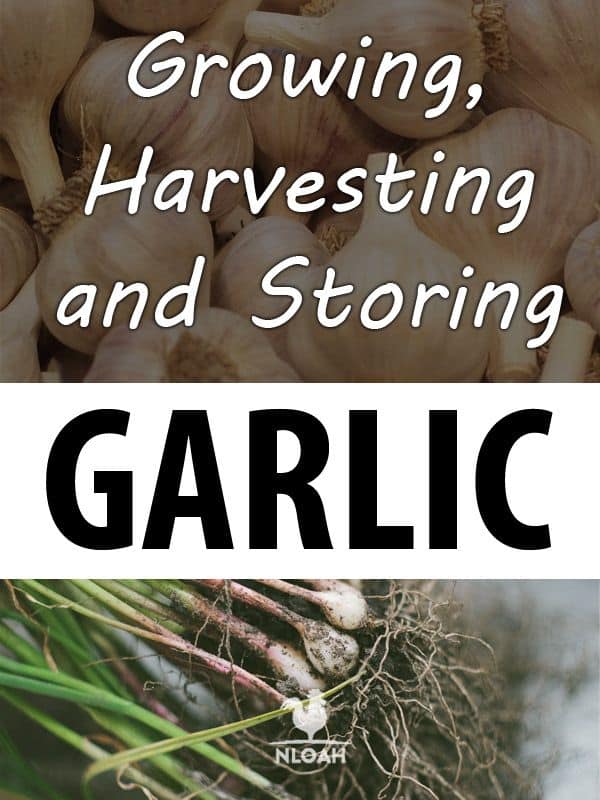

Allison Sayer lives in a schoolbus on an off-grid property in the Alaskan Copper Valley. She has been part of many amazing projects. These include cooking at a remote nature center, managing a multi-family hoop house, volunteering at a chicken sanctuary, and WWOOFing on a small farm. Through her deep friendships throughout the Alaskan wilderness, she has helped many friends develop their homes and dreams. Allison is currently building up her property with the goal of starting her own microgreen farm.

I have grown hard neck garlic for several years in eastern NC quite successfully. I have raised beds and grow about 25 plants every winter.
Your article was spot on and excellent advice. This is a keeper to reference.
Thank you.
Gilroy, CA? Most garlic in the stores here in CT comes from China or Spain!